There is a very simple method for trading cryptocurrencies that almost guarantees a 100% profit. I made over 20 million using this method!
Many people ask me about buying strategies? There is indeed one! This is the phased 343 position-building method: After determining the currency to buy, prepare cash, for example, if the initial actual financing is 300,000, allocate 120,000 to BTC.
① 3: Use 30% of the current funds for position building, which means 36,000 (12 times 0.3) for the first position building.
② 4: If the price begins to rise after building a position, wait for the price to adjust before adding positions. Do not rush to add positions; after the price adjusts, use 40% of the current funds to add positions (any rise will have a pullback).
If the market is not good after opening a position and starts to decline, every time the BTC price falls by 10%, add 10% of the remaining funds to the position (3,600), until fully added. This situation is rare, but even if it happens, don’t be afraid, because it’s a phased construction, and your price has been averaged out (and there’s still 40% of total funds to be added, referring to the 4 in the 4321 strategy).
③ 3: If the price begins to rise after adding positions, wait for the price to adjust, and after the price adjusts, add positions again. Use 30% of the current funds to add positions, at this point, the phased position building is complete. Overcome fear and control greed!!! If you only want to sell at the highest point, you will only get stuck, because there is no highest point in your mind.
My net worth is 150 million, of which about 130 million was earned through trading cryptocurrency! I take out 100,000 RMB from the cryptocurrency circle every month, feeling no impact, living leisurely, free and unrestrained, without deceit or intrigue, living the life I desire. Today, I will share some valuable insights; these experiences are worth 60 million, hoping to help you.
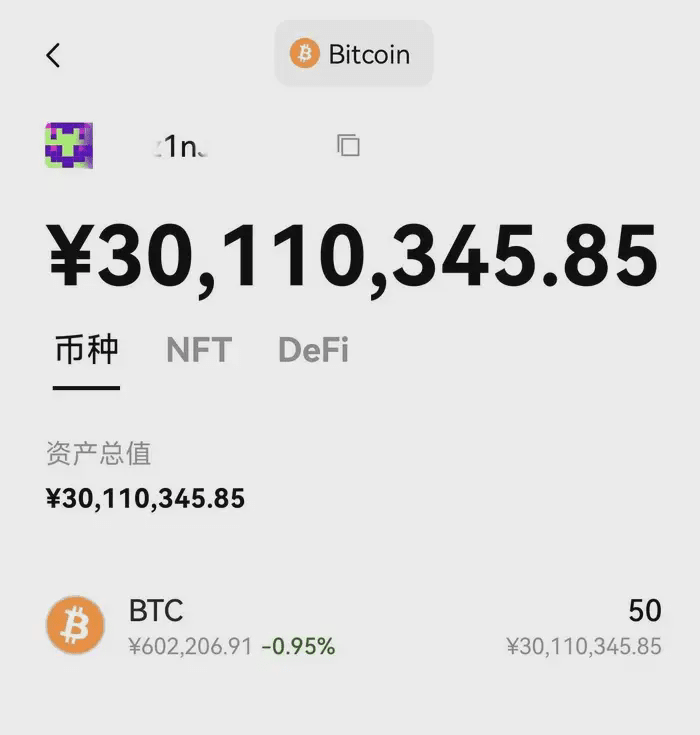
In the cryptocurrency circle, achieving financial freedom and class leaps, I have summarized 10 trading tips. Understanding one of them can help you achieve stable profits, and they are worth learning repeatedly:
1. Two-Way Trading: Suitable for bull and bear markets. Two-way trading is currently the most common trading method on the Jushi Wealth GGtrade platform. It allows for operations and investments according to the trends of the cryptocurrency market, enabling both bullish and bearish trades. Moreover, as the year ends, the Jushi Wealth GGtrade platform has launched a series of benefits, such as a 20% increase in investment returns, which is indeed a great blessing for many investors.
2. Coin Hoarding Method: Suitable for bull and bear markets. The coin hoarding method is the simplest, yet the most difficult way to play. It is simple because it involves buying one or several coins and holding them for more than six months or a year without operation. Generally, the minimum return is tenfold. However, novices often see high returns or encounter a situation where the coin price is halved and plan to switch or exit. Many people find it hard to persist for a month without operating, let alone a year. So this is indeed the most challenging.
3. Bull Market Catch-up Method: Only suitable for bull markets. Use a portion of idle money, preferably not exceeding one-fifth of your funds. This method is suitable for coins with a market value between 20 and 100, as you won't be stuck for too long. For example, if you buy the first altcoin, wait for it to rise by 50% or more before switching to the next coin that has fallen sharply, and repeat this cycle. If you get stuck in the first altcoin, just wait; the bull market will surely release you. However, the prerequisite is that the coin cannot be a total scam, and this method is not easy to control; newcomers need to be cautious.
4. Hourglass Switching Method: Suitable for bull markets. In a bull market, buying almost any coin will yield profits. Funds act like a giant hourglass, slowly seeping into every coin, starting from large coins. There is a clear pattern in coin price increases: leading coins rise first, like BTC, ETH, DASH, ETC, followed by mainstream coins like LTC, XMR, EOS, NEO, QTUM, etc. Then various small coins take turns to rise. However, if Bitcoin rises, choose the next level, coins that have not yet risen, and start building positions.
5. Pyramid Bottom Buying Method: Suitable for predicted major crashes. The bottom-buying method: Place orders to buy a tenth of the position at 80% of the coin price, a twentieth of the position at 70%, a third of the position at 60%, and a fourth of the position at 50%.
6. Moving Average Method: You need to understand some K-line basics. Set the indicator parameters to MA5, MA10, MA20, MA30, MA60, and select a daily chart. If the current price is above MA5 and MA10, hold it steady. If MA5 falls below MA10, sell the coin; if MA5 rises above MA10, buy and build positions.
7. Violent Coin Hoarding Method: Only suitable for quality long-term coins you are familiar with. With a liquid fund, if a coin's current price is 8 USD, then place an order to buy at 7 USD. When the purchase is executed successfully, place an order to sell at 8.8 USD. The profit goes to hoarding coins. The liquid funds can be taken out to wait for the next opportunity. If there are three such opportunities in a month, you can hoard quite a few coins. The formula is that the entry price equals the current price multiplied by 90%, and the selling price equals the current price multiplied by 110%!
8. ICO Violent Compound Interest Method: Continuously participate in ICOs, when the new coin's price increases to 3-5 times, take back the principal, and invest in the next ICO, keeping the profits cycling.
9. Cyclical Wave Method: Find coins like ETC, which are in a downtrend and add positions as the price continues to fall, then wait for profits and continue to sell, repeating the cycle.
10. Small Coin Violent Play: If you have 10,000 RMB, divide it into ten portions, buy ten different types of small coins, preferably under 3 RMB each. After buying, don’t pay attention. Don’t sell until it rises 3-5 times; if stuck, don’t sell, just hold it long-term. If a certain coin triples, take back the principal of 1,000 RMB and invest in the next small coin. The compound interest return can be quite impressive!
I will share a set of practical strategies I've developed over the years with an average win rate of 80%. This is quite a rare achievement in the cryptocurrency trading community.
I have organized the essence of the [K-line strategy]. As long as you master it, relying on this method to trade cryptocurrencies will guarantee your account multiplies 30 times. Today, I specially organized this valuable content to share with those destined to receive it; be sure to keep it well.
As a newcomer in the cryptocurrency circle, K-line is essential knowledge. It is the foundation of all technical analysis. Learning to interpret K-line charts is crucial for grasping currency trends. ㅤ
The most fundamental indicators in the cryptocurrency market: K-line, trading volume ㅤ
What is a K-line chart? The K-line chart, also known as the candlestick chart, is one of the most commonly used tools in cryptocurrency analysis. It visually displays price changes in the cryptocurrency market, allowing you to see the rise and fall at a glance.
Basic structure of K-line: Each K-line represents the price changes of a certain period, with common time units such as 1 minute, 5 minutes, daily, etc. Highest point: K-line's upper shadow. Lowest point: K-line's lower shadow.
Common patterns of K-line charts: Solid bullish and solid bearish candles (large bullish candles/large bearish candles): Indicate that the price fluctuation in the cryptocurrency market is significant. Doji: Indicates market uncertainty, and a reversal may occur at the point. Hammer line: Signals a bottom reversal, which is a potential buying signal.
How to use K-line charts for cryptocurrency analysis?
Look for trends: By analyzing the arrangement of K-lines, determine the upward, downward, or oscillating trends in the cryptocurrency market.
Combine with other indicators: such as moving averages, MACD, etc., to enhance the accuracy of judgments.
Set buy and sell points: Consider entering and exiting when a reversal pattern appears on the K-line chart.
Now, Old Seven will introduce K-lines that are often encountered in the cryptocurrency circle.
1. Doji
Doji
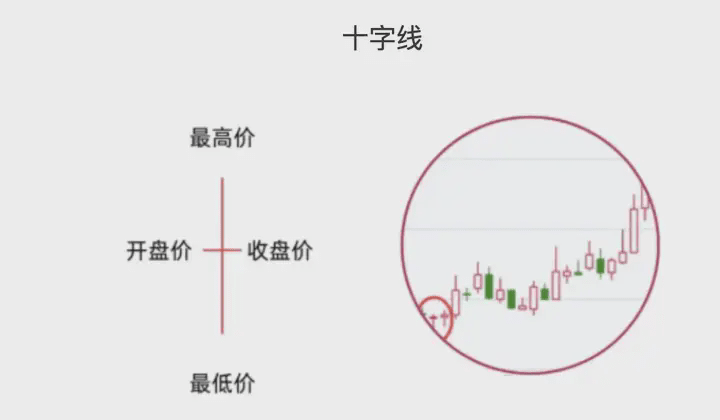
Doji reveals the fact that bullish and bearish forces are balanced. Generally speaking, a trend reversal is likely to occur after a doji, altering the previous trend direction. If a doji appears during an uptrend, it reveals a weakening of the upward momentum; if it appears during a downtrend, it reveals a weakening of the downward momentum; if it appears in a sideways trend or multiple doji appear near the same price level, then the doji cannot provide a trend change signal.
2. T-line
T-line
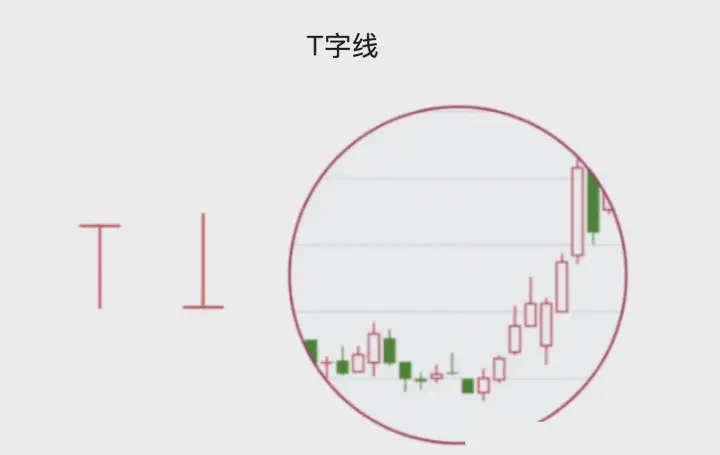
The T-line appearing in a low price area indicates strong support and the possibility of a rebound.
The T-line appearing at a high price level indicates severe selling pressure and weak market conditions, with a possibility of a reversal downwards.
If the T-line appears during the upward movement in the mid-level area, it indicates that there is still upward space in the future.
3. Solid Bullish Candles and Solid Bearish Candles
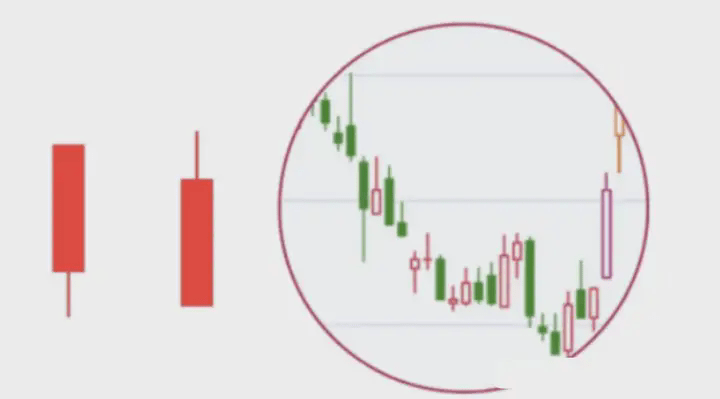
A solid bullish candle with a body and a lower shadow, but no upper shadow. If a solid bullish candle appears in a low price area, it indicates that it may mark the beginning of a new upward trend; if it appears during an upward trend, it indicates continued optimism for the future.
A solid bullish candle, which has a body and is hollow, has an upper shadow and no lower shadow, indicates a strong upward momentum.
4. Solid Bullish and Solid Bearish Candles
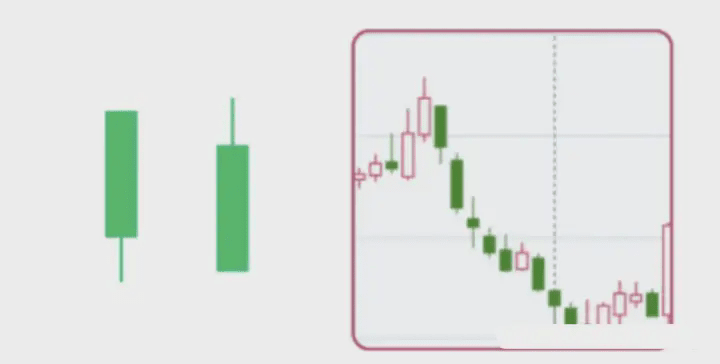
A solid bearish candle refers to a bearish candle with a lower shadow, where the opening price is the highest price of the day. Once opened, the selling power is particularly strong, and the price remains in a downward state, but when it falls to a low level, it is supported by buying power, which may lead to a rebound.
A solid bearish candle, which has a bearish body, an upper shadow, and no lower shadow. If a solid bearish candle appears in a low price area, it indicates that there may be signs of a rebound, but the rebound is not significant.
5. Solid Bullish and Solid Bearish Candles
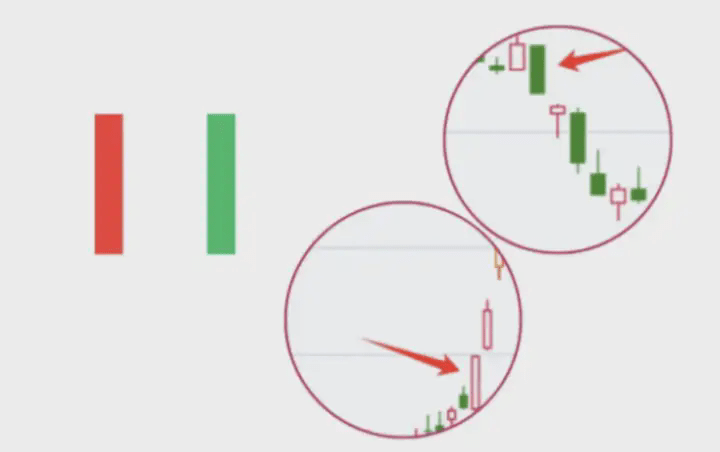
A solid bullish and solid bearish candle, which has a body and no upper or lower shadows. A solid bullish and solid bearish candle indicates an upward trend, and the subsequent trend is likely to be strongly bullish.
A solid bearish and solid bullish candle, which has a body and no upper or lower shadows. A solid bearish and solid bullish candle indicates a downward trend, and the subsequent trend is likely to be strongly bearish, with a high possibility of a low opening the next day.
6. Small Bullish and Bearish Candles
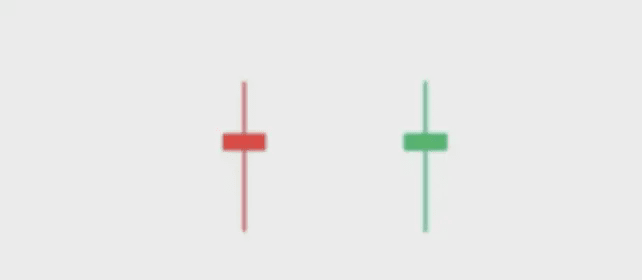
The body part of small bullish and bearish candles is quite short.
A small bullish star represents very minimal price movement, with the opening price and closing price extremely close, and the closing price slightly higher than the opening price. The appearance of a small bullish star indicates that the trend is in a chaotic and unclear phase, making it difficult to predict future price movements.
A small bearish star is similar to a small bullish star, but the closing price is slightly lower than the opening price, indicating that the trend is in a chaotic and unclear phase, making it difficult to predict future price movements.
7. Small Bullish and Bearish Candles
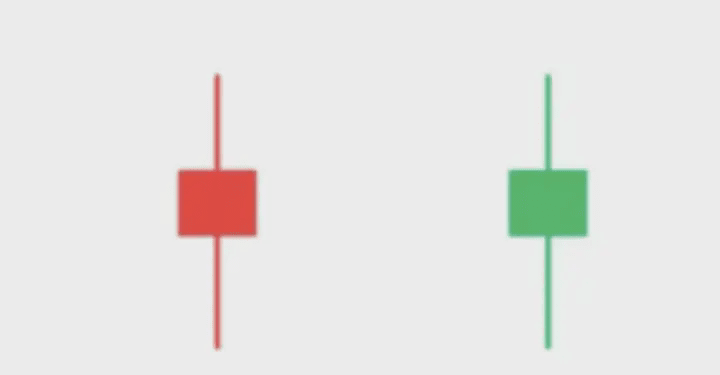
The body part of small bullish and bearish candles is slightly longer than that of small bullish and bearish stars.
The fluctuation range of small bullish and small bearish candles is between 0.6% and 1.5%. A small bullish candle indicates a lack of momentum in the upward trend, making the subsequent trend unclear.
A small bearish candle indicates signs of downward movement, but with limited downward momentum and the subsequent trend not being very clear.
8. Medium Bullish and Medium Bearish Candles
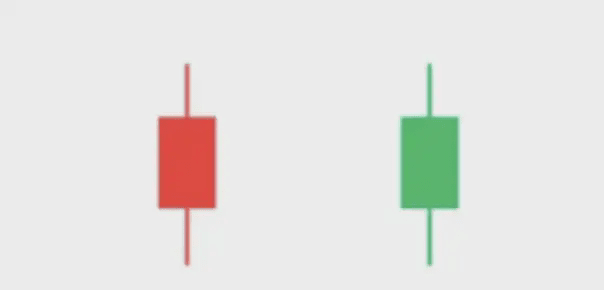
The body part of medium bullish and bearish candles is slightly longer than that of small bullish and bearish candles.
Different from small bullish and bearish candles, the market significance of bullish and medium bearish candles is clearer. A medium bullish candle indicates bullish sentiment, while a medium bearish candle indicates bearish sentiment. Many times, medium bullish and bearish candles often become turning points in trends, but overall trends should also be analyzed.
9. Large Bullish and Bearish Candles
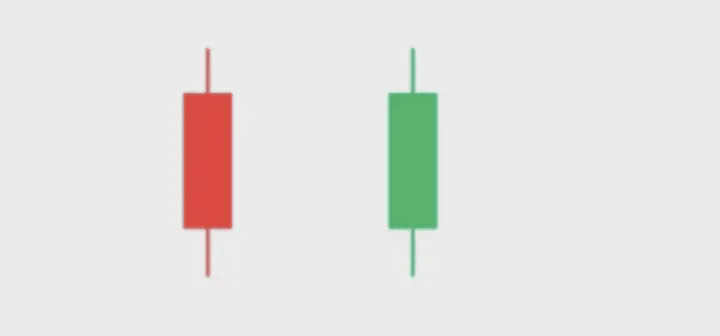
The fluctuation range of large bullish and bearish candles is above 3.6%, and compared to medium bullish and bearish candles, the market significance of large bullish and bearish candles is clearer.
A large bullish candle indicates that the likelihood of upward movement dominates, making a high opening the next day likely; a large bearish candle indicates that the likelihood of downward movement dominates, making a low opening the next day likely.
10. Hammer Line/Hammer Candle
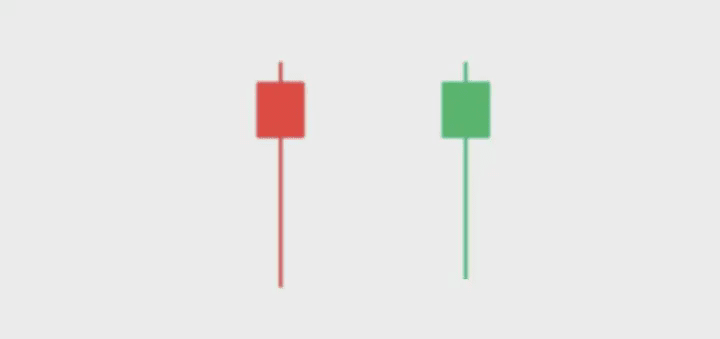
The body is relatively small, the lower shadow is long (2-3 times + the body), with no upper shadow or only a very short upper shadow. At high levels, it is also known as a 'hanging man'.
(1) If it appears at a high price level, it is a signal of a market peak; if at a low price level, it is a signal of a market bottom.
(2) The smaller the hammer body, the longer the lower shadow, the greater the reference value.
(3) After a hammer line appears, if the next K-line closes as a longer solid bullish candle and its closing price exceeds the highest price of the hammer line, the probability of a new upward trend is high.
(4) If a hammer line appears, if the next K-line is a large bearish line, the market may maintain a downward trend.
11. Inverted Hammer Line
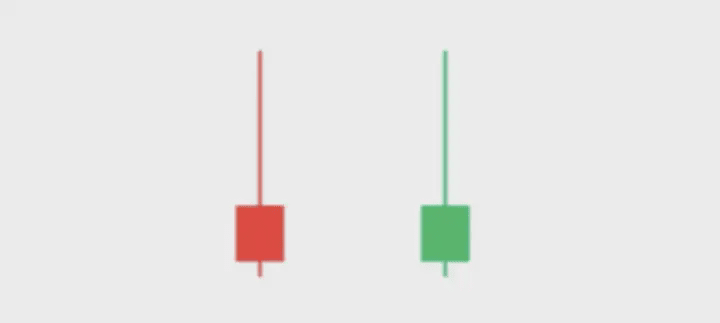
The body is relatively short, the upper shadow is long, with no lower shadow or only a very short lower shadow.
(1) If at a high price level, it is a signal of a market peak, sell the stocks; if at a low price level, it is a potential signal of a market bottom.
(2) The more disparate the ratio of the body to the upper shadow, the more reference value the signal has.
(3) An inverted hammer line is not a strong bullish signal. After an inverted hammer line appears, you must wait for the next K-line to verify it.
(4) If the opening price the next day jumps above the body of the inverted hammer, the larger the gap, the stronger the confirmation signal.
12. Summary of Bullish Candles
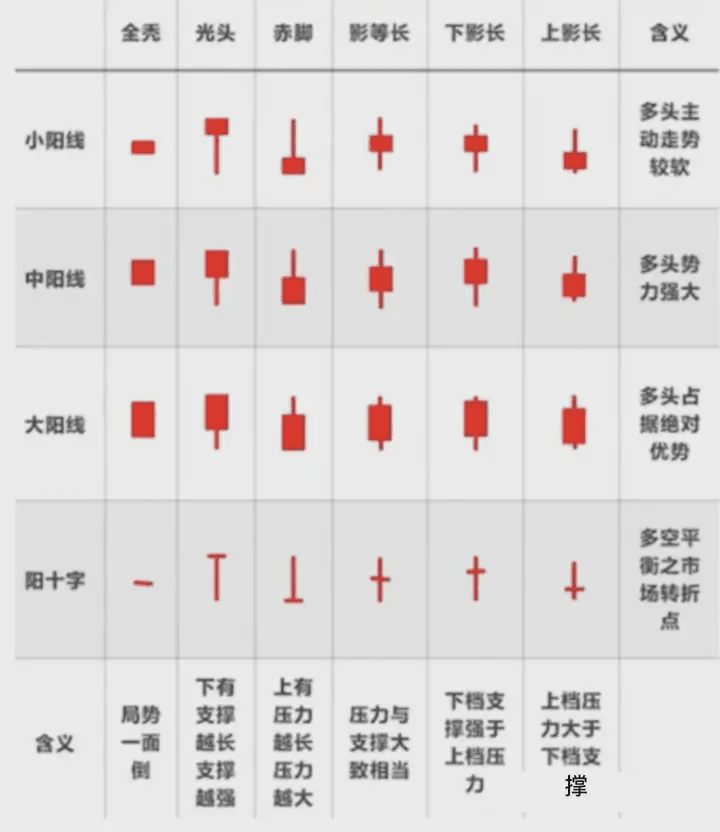
13. Summary of Bearish Candles
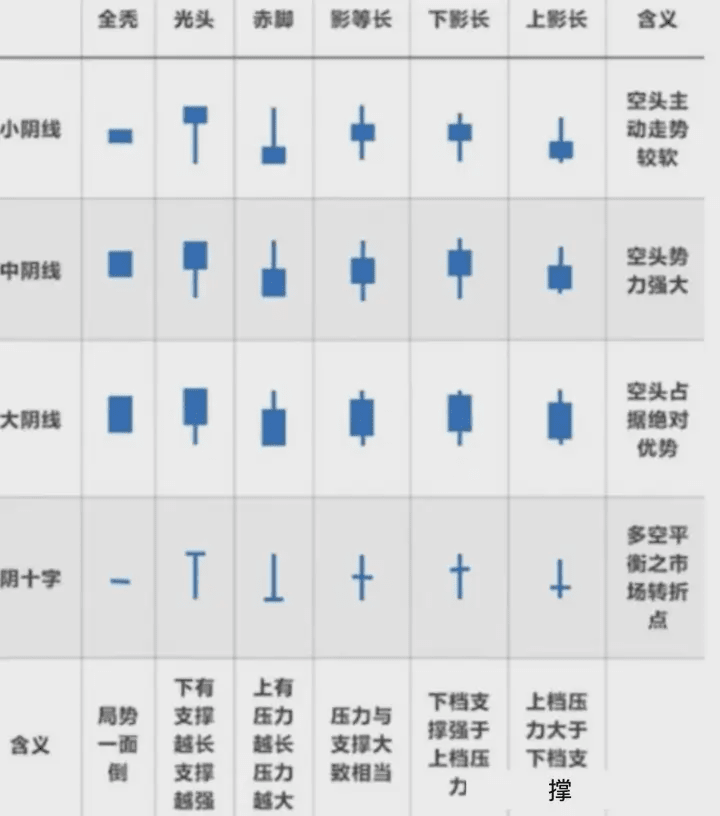
The practical techniques for intraday trading are as follows: First, choose the trading currency.
Select trading varieties with good intraday volatility.
For these coins, try to minimize the fluctuations of the peripheral market while considering intraday trading costs.
Some exchanges have high intraday trading costs for certain coins and should gradually be eliminated.
Observe the cyclical performance of the coins.
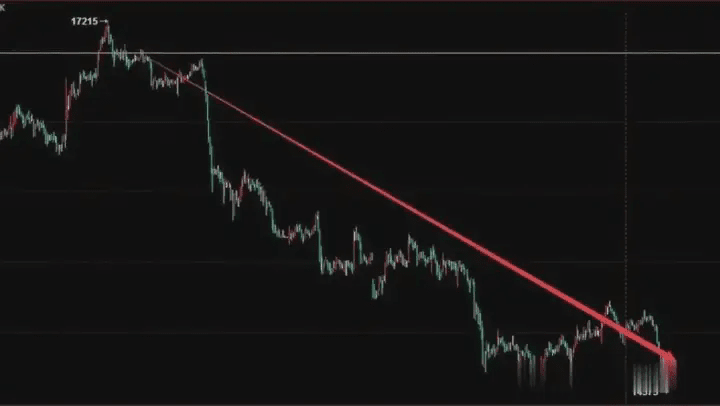
Coins are affected by each cycle stage. It is necessary to determine whether the market is rising, falling, or consolidating based on daily level cycles.
Consider the main factors that revolve around the logical reasoning of this stage, which produce support or pressure at certain price levels.
Select the observation period for intraday trading.
There are 15 15-minute K-line charts in a day, 75 5-minute K-line charts, and 8 hourly K-line charts. Different coins have different closing times at night, and K-line charts can be calculated using this method. Choose good entry points, control your positions, and sell at appropriate points.
Cost line selection
Prices are driven by funds trading, so when intraday markets are generated, it is generally found to run along a certain trend line, in line with minimizing marginal costs.
Important K-line auxiliary trends
The patterns of K-lines, especially the sunny or shady days in the 5-minute or 15-minute timeframe, are worth studying. In the beginning, trends need this K-line to establish, and based on predictions, one should intervene at the first opportunity.
Phased position building.
Any trade is merely a trial and error, which determines that going all in may suffer significant blows. Therefore, phased attacks are the best strategy. Based on the established position funds, you can adopt a 1:2:1 strategy. From experience, intraday contract trading is suitable for several time frames of K-lines: 1-minute, 3-minute, and 5-minute.
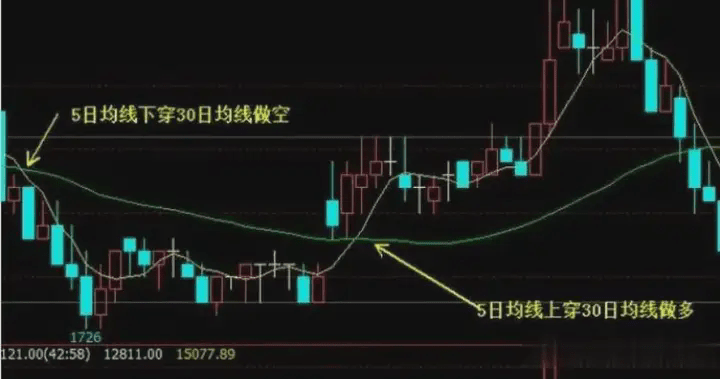
1-minute line: Commonly known as 'snatching hats'. This trading method is about obtaining profits from extremely short trading opportunities, requiring traders to have no patience. Quick entry and exit. Generally, each profit will not be too much, and the stop-loss points set during trading are also few.
Also, in this trading method, handling fees take up a large proportion of profits, generally suitable for low-fee or intraday trading. Another point to note is that some coins' 1-minute K-lines are not very active, and traders should try to avoid these coins.
3-minute line: The 3-minute line is often used by many intraday traders during this time period, with many trading opportunities every day. The price of the currency is set within a fluctuation range, which also has a certain trend, avoiding situations where some indicators become ineffective due to excessive fluctuations in the 1-minute line.
This trading operation method allows for setting larger profit targets each time, and the stop-loss range can also be appropriately widened.
5-minute line: This can further stabilize operations based on the 3-minute line. Although daily trading opportunities are fewer than on the 3-minute line, once a trading pattern appears, it is relatively stable, and monitoring is not as tiring as with the 3-minute line.
One-Third Method, which is an operation of fund management, divides the account funds into three parts to ensure that you do not engage in full position trading.
Funds are our lifeline, and we must ensure the safety of our lives.
The application of the One-Third Method is to build positions using one-third of the funds. After building a position, if its direction is correct, we keep one-third and do not chase orders in between. Chasing orders often increases risk.
The One-Third Method can be broken down into One-Sixth Method, One-Ninth Method, making operations more flexible.
When stuck in cryptocurrency trading, how should we respond? Trading skills.
First, let me explain some basic techniques. When the market is good, there’s nothing to say, it’s definitely profitable. But what do we do when it’s not good? This is what tests everyone, after all, doing anything requires experience and resilience to earn money.
Eight cryptocurrency trading mantras, shared with everyone.
Cryptocurrency trading mantra one: When stuck, add positions to seek break-even; aspiring for profits is greed.
Cryptocurrency trading mantra two: On a calm surface, there is a high wave coming; beware of the big wave behind.
Cryptocurrency trading mantra three: After a big rise, there must be a pullback; K-lines will draw a triangle over several days.
Cryptocurrency trading mantra four: Buy bearish, not bullish; sell bullish, not bearish; moving against the market makes you a hero.
Cryptocurrency trading mantra five: Don’t sell at highs, don’t buy at dips, don’t trade during sideways movements.
Cryptocurrency trading mantra six: Look for support levels in an upward trend and resistance levels in a downward trend.
Cryptocurrency trading mantra seven: Full position trading is a big taboo; stubbornness is not advisable; be aware of constant changes; be at ease when entering and exiting.
Cryptocurrency trading mantra eight: Trading cryptocurrency is about mindset; greed and fear are major harms. Be cautious when chasing rises and falls; maintain a calm and free mindset.


